2012 FORD F750 suspension
[x] Cancel search: suspensionPage 2 of 306

Seating and Safety Restraints 69
Seating 69
Rear seats 78
Safety restraints 80
Child restraints 89
Driving 103
Starting 103
Brakes 110
Air suspension 129
Transmission operation 132
Vehicle loading 146
Roadside Emergencies 152
Hazard flasher switch 153
Fuses and relays 153
Jump starting 162
Wrecker towing 166
Customer Assistance 170
Getting assistance outside the U.S. and Canada 172
Reporting safety defects (U.S. only) 174
Reporting safety defects (Canada only) 174
Cleaning 175
Underbody preservation 179
Maintenance and Specifications 181
Hood 189
Engine oil 192
Battery 195
Engine coolant 197
Fuel information 204
Diesel Exhaust Fluid (DEF) 210
Wheel lug nut torque 237
Tire information 238
Lubricant specifications 245
Refill capacities 259
Engine data 262
Table of Contents
2
2012 F-650/750(f67)
Supplement, 2nd Printing
USA(fus)
Page 14 of 306
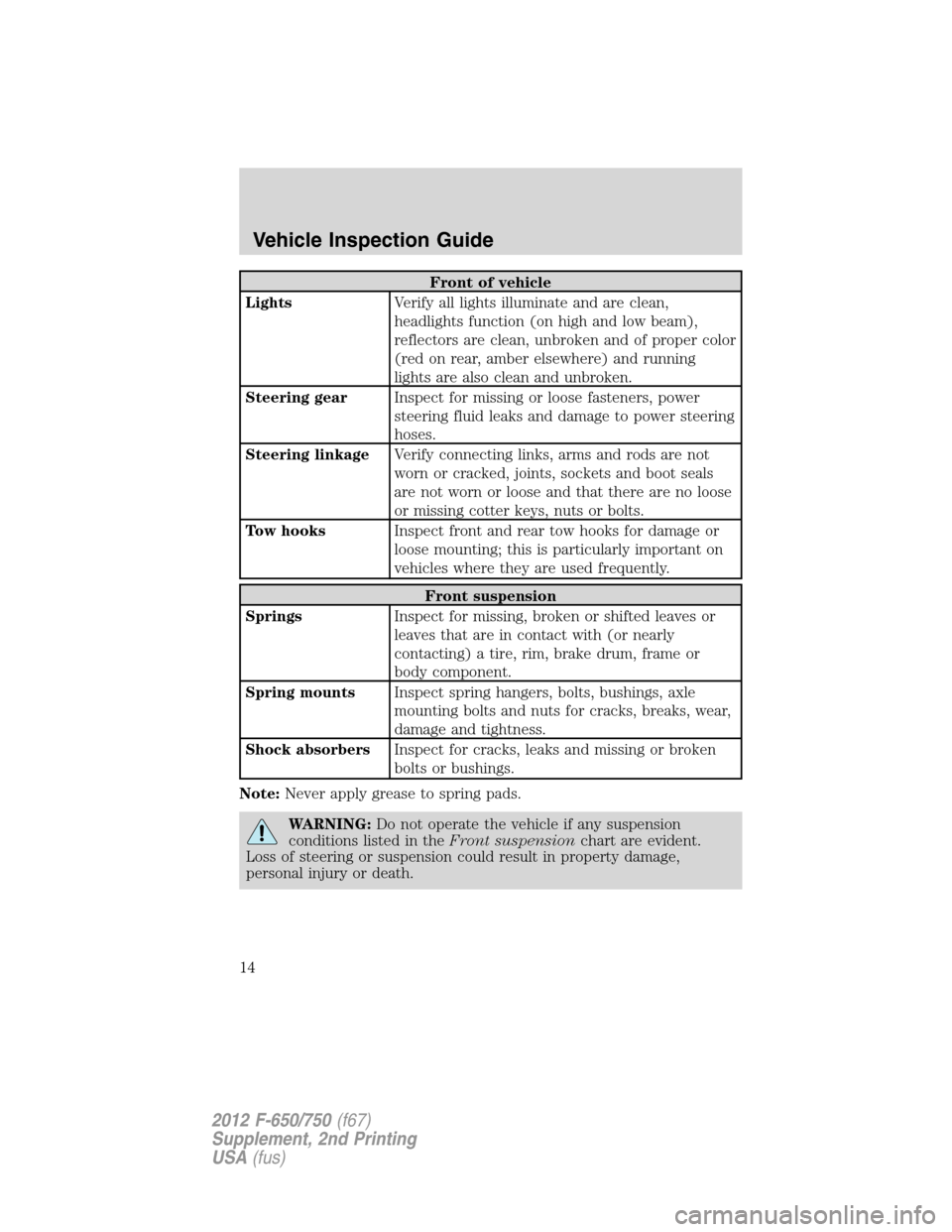
Front of vehicle
LightsVerify all lights illuminate and are clean,
headlights function (on high and low beam),
reflectors are clean, unbroken and of proper color
(red on rear, amber elsewhere) and running
lights are also clean and unbroken.
Steering gearInspect for missing or loose fasteners, power
steering fluid leaks and damage to power steering
hoses.
Steering linkageVerify connecting links, arms and rods are not
worn or cracked, joints, sockets and boot seals
are not worn or loose and that there are no loose
or missing cotter keys, nuts or bolts.
Tow hooksInspect front and rear tow hooks for damage or
loose mounting; this is particularly important on
vehicles where they are used frequently.
Front suspension
SpringsInspect for missing, broken or shifted leaves or
leaves that are in contact with (or nearly
contacting) a tire, rim, brake drum, frame or
body component.
Spring mountsInspect spring hangers, bolts, bushings, axle
mounting bolts and nuts for cracks, breaks, wear,
damage and tightness.
Shock absorbersInspect for cracks, leaks and missing or broken
bolts or bushings.
Note:Never apply grease to spring pads.
WARNING:Do not operate the vehicle if any suspension
conditions listed in theFront suspensionchart are evident.
Loss of steering or suspension could result in property damage,
personal injury or death.
Vehicle Inspection Guide
14
2012 F-650/750(f67)
Supplement, 2nd Printing
USA(fus)
Page 18 of 306
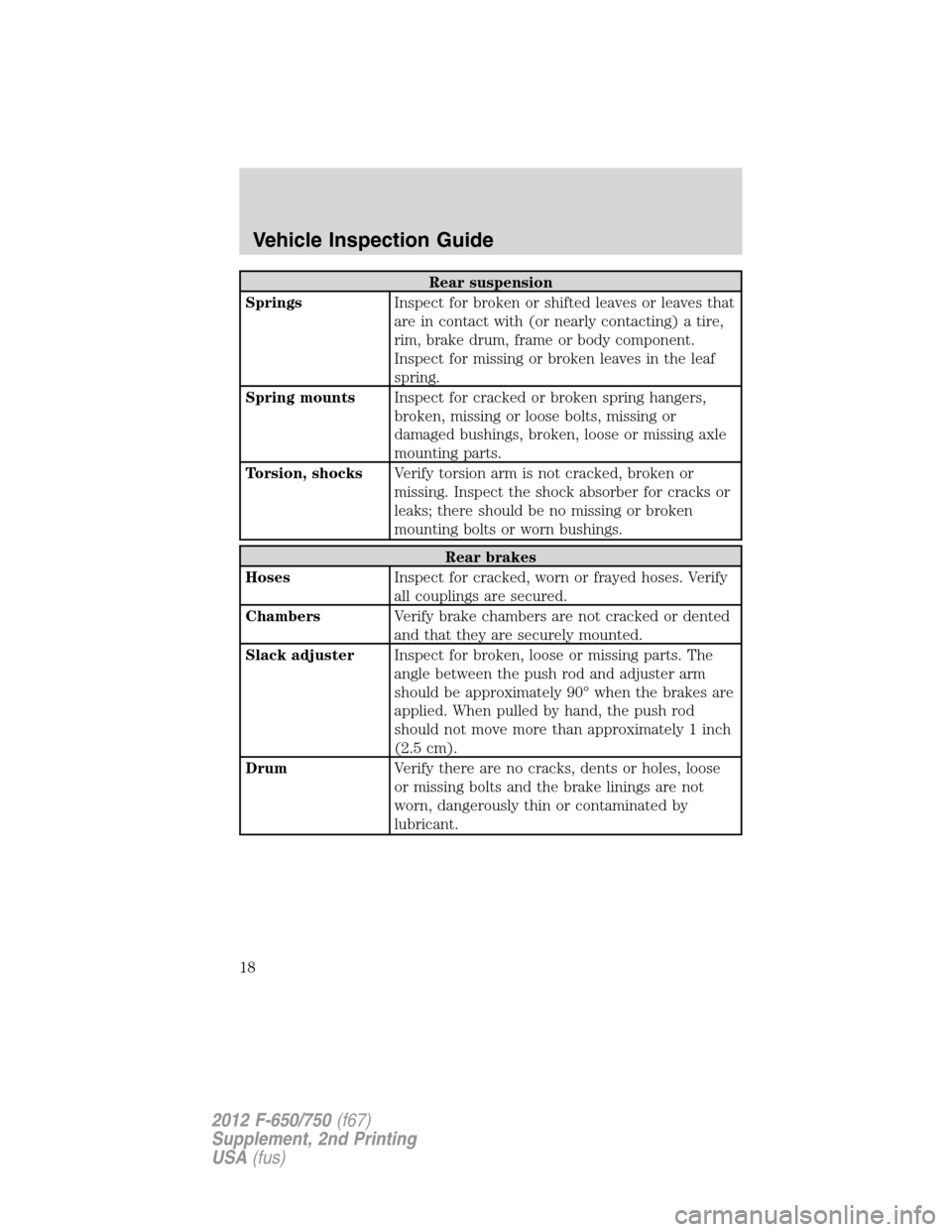
Rear suspension
SpringsInspect for broken or shifted leaves or leaves that
are in contact with (or nearly contacting) a tire,
rim, brake drum, frame or body component.
Inspect for missing or broken leaves in the leaf
spring.
Spring mountsInspect for cracked or broken spring hangers,
broken, missing or loose bolts, missing or
damaged bushings, broken, loose or missing axle
mounting parts.
Torsion, shocksVerify torsion arm is not cracked, broken or
missing. Inspect the shock absorber for cracks or
leaks; there should be no missing or broken
mounting bolts or worn bushings.
Rear brakes
HosesInspect for cracked, worn or frayed hoses. Verify
all couplings are secured.
ChambersVerify brake chambers are not cracked or dented
and that they are securely mounted.
Slack adjusterInspect for broken, loose or missing parts. The
angle between the push rod and adjuster arm
should be approximately 90° when the brakes are
applied. When pulled by hand, the push rod
should not move more than approximately 1 inch
(2.5 cm).
DrumVerify there are no cracks, dents or holes, loose
or missing bolts and the brake linings are not
worn, dangerously thin or contaminated by
lubricant.
Vehicle Inspection Guide
18
2012 F-650/750(f67)
Supplement, 2nd Printing
USA(fus)
Page 19 of 306
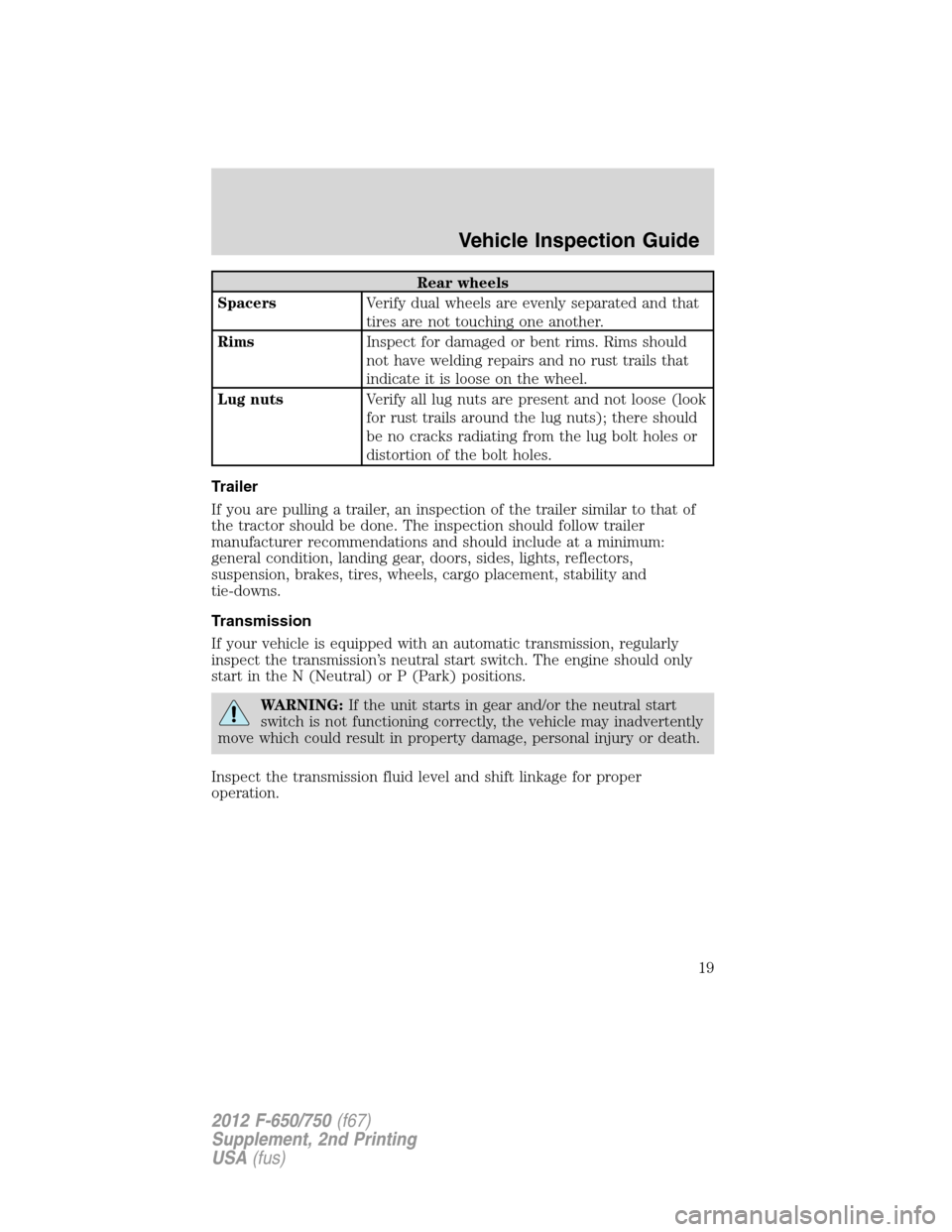
Rear wheels
SpacersVerify dual wheels are evenly separated and that
tires are not touching one another.
RimsInspect for damaged or bent rims. Rims should
not have welding repairs and no rust trails that
indicate it is loose on the wheel.
Lug nutsVerify all lug nuts are present and not loose (look
for rust trails around the lug nuts); there should
be no cracks radiating from the lug bolt holes or
distortion of the bolt holes.
Trailer
If you are pulling a trailer, an inspection of the trailer similar to that of
the tractor should be done. The inspection should follow trailer
manufacturer recommendations and should include at a minimum:
general condition, landing gear, doors, sides, lights, reflectors,
suspension, brakes, tires, wheels, cargo placement, stability and
tie-downs.
Transmission
If your vehicle is equipped with an automatic transmission, regularly
inspect the transmission’s neutral start switch. The engine should only
start in the N (Neutral) or P (Park) positions.
WARNING:If the unit starts in gear and/or the neutral start
switch is not functioning correctly, the vehicle may inadvertently
move which could result in property damage, personal injury or death.
Inspect the transmission fluid level and shift linkage for proper
operation.
Vehicle Inspection Guide
19
2012 F-650/750(f67)
Supplement, 2nd Printing
USA(fus)
Page 22 of 306

Charging system:Illuminates when
the battery is not charging properly.
If it stays on while the engine is
running, there may be a malfunction
with the charging system or a related component. Contact your
authorized dealer as soon as possible.
Check fuel cap (gasoline engine
only):Illuminates when the fuel cap
may not be properly installed.
Continued driving with this light on
may cause the service engine soon
warning indicator to illuminate.
Check suspension (if equipped):
Illuminates when the air suspension
dump switch has been activated.
Check trans (Allison automatic
transmission only):Illuminates
while driving if a problem has been
detected and shifting may be
restricted. Depending upon the
severity of the problem, the
read-out digit on the shifter display
may be blank.
On MD 3000 series transmissions,operation may continue in order to
reach service assistance. The ECU may not respond to shift selector
requests, since operating limitations are being placed on the
transmission, i.e. upshifts and downshifts may be restricted. Direction
changes do not occur.
Refer to your transmission operator’s manual for more information.
Diesel exhaust fluid (diesel
engine only):Illuminates when the
diesel exhaust fluid level falls below
0.5 gallon (1.9L) in the 5 gallon
(19.0L) tank or 1 gallon (3.8L) in
the 9 gallon (34.0L) tank. Refill the
tank or, at a minimum, add at least
1 gallon (3.8L) to the 5 gallon
(19.0L) tank or 2 gallons (7.6L) to the 9 gallon (34.0L) tank.
Instrument Cluster
22
2012 F-650/750(f67)
Supplement, 2nd Printing
USA(fus)
Page 129 of 306
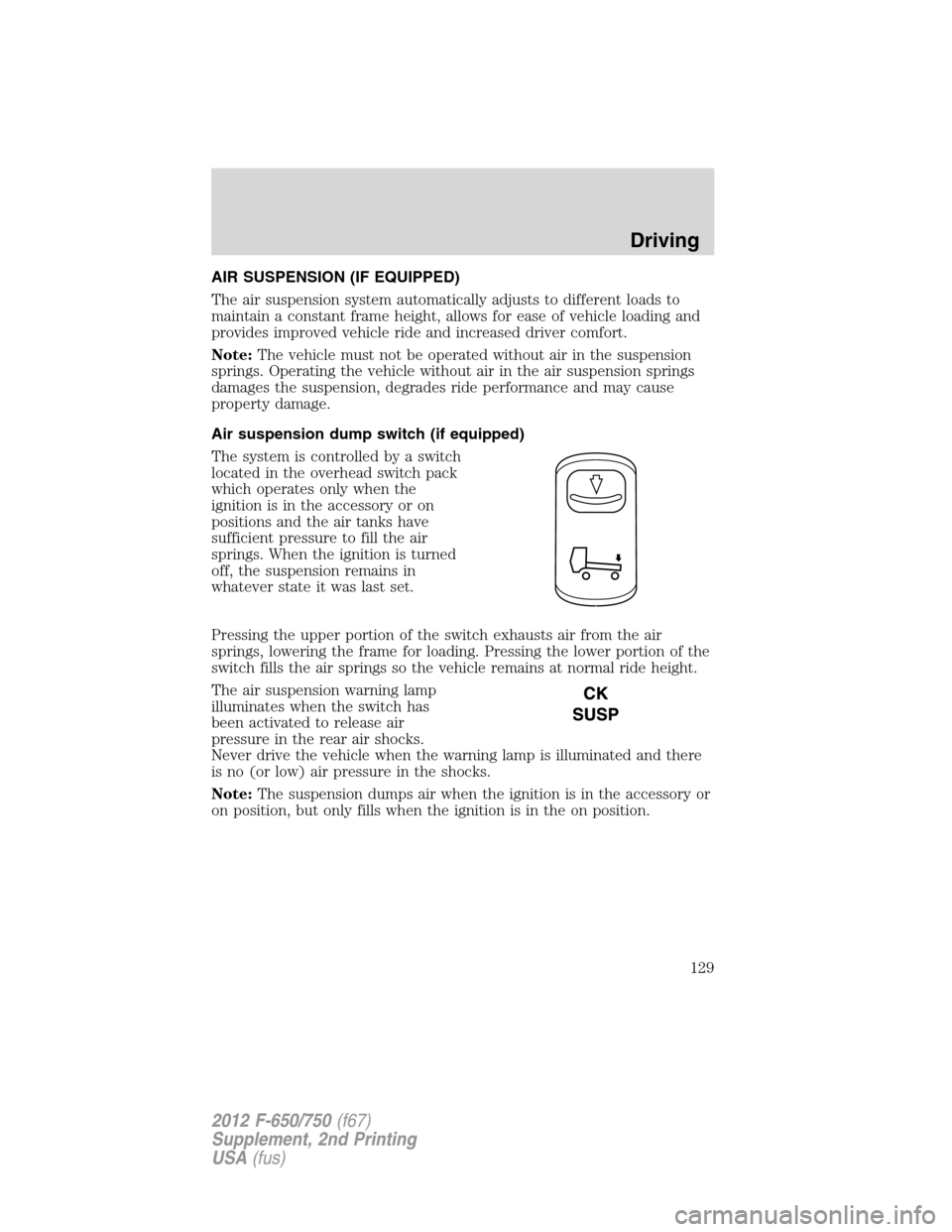
AIR SUSPENSION (IF EQUIPPED)
The air suspension system automatically adjusts to different loads to
maintain a constant frame height, allows for ease of vehicle loading and
provides improved vehicle ride and increased driver comfort.
Note:The vehicle must not be operated without air in the suspension
springs. Operating the vehicle without air in the air suspension springs
damages the suspension, degrades ride performance and may cause
property damage.
Air suspension dump switch (if equipped)
The system is controlled by a switch
located in the overhead switch pack
which operates only when the
ignition is in the accessory or on
positions and the air tanks have
sufficient pressure to fill the air
springs. When the ignition is turned
off, the suspension remains in
whatever state it was last set.
Pressing the upper portion of the switch exhausts air from the air
springs, lowering the frame for loading. Pressing the lower portion of the
switch fills the air springs so the vehicle remains at normal ride height.
The air suspension warning lamp
illuminates when the switch has
been activated to release air
pressure in the rear air shocks.
Never drive the vehicle when the warning lamp is illuminated and there
is no (or low) air pressure in the shocks.
Note:The suspension dumps air when the ignition is in the accessory or
on position, but only fills when the ignition is in the on position.
Driving
129
2012 F-650/750(f67)
Supplement, 2nd Printing
USA(fus)
Page 130 of 306
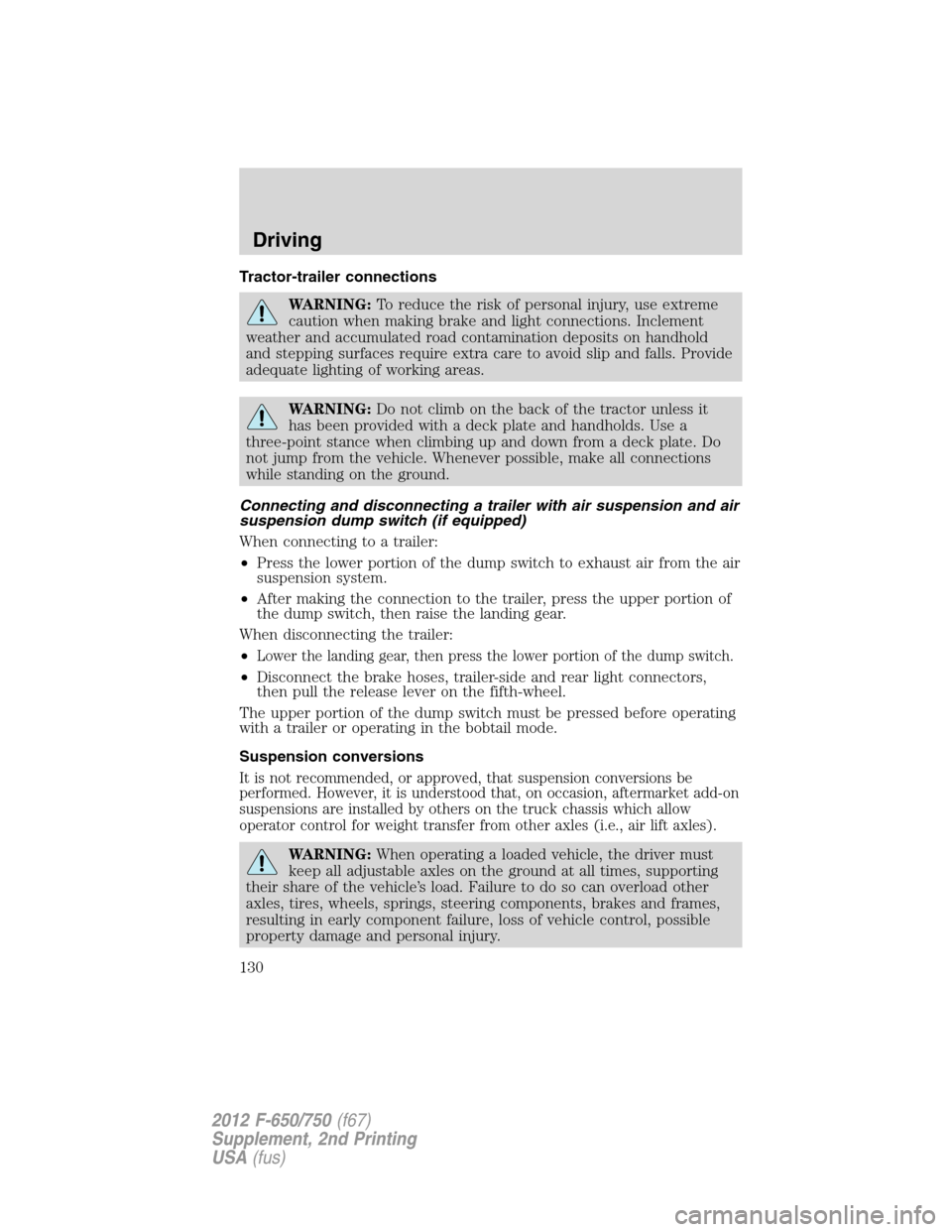
Tractor-trailer connections
WARNING:To reduce the risk of personal injury, use extreme
caution when making brake and light connections. Inclement
weather and accumulated road contamination deposits on handhold
and stepping surfaces require extra care to avoid slip and falls. Provide
adequate lighting of working areas.
WARNING:Do not climb on the back of the tractor unless it
has been provided with a deck plate and handholds. Use a
three-point stance when climbing up and down from a deck plate. Do
not jump from the vehicle. Whenever possible, make all connections
while standing on the ground.
Connecting and disconnecting a trailer with air suspension and air
suspension dump switch (if equipped)
When connecting to a trailer:
•Press the lower portion of the dump switch to exhaust air from the air
suspension system.
•After making the connection to the trailer, press the upper portion of
the dump switch, then raise the landing gear.
When disconnecting the trailer:
•
Lower the landing gear, then press the lower portion of the dump switch.
•Disconnect the brake hoses, trailer-side and rear light connectors,
then pull the release lever on the fifth-wheel.
The upper portion of the dump switch must be pressed before operating
with a trailer or operating in the bobtail mode.
Suspension conversions
It is not recommended, or approved, that suspension conversions be
performed. However, it is understood that, on occasion, aftermarket add-on
suspensions are installed by others on the truck chassis which allow
operator control for weight transfer from other axles (i.e., air lift axles).
WARNING:When operating a loaded vehicle, the driver must
keep all adjustable axles on the ground at all times, supporting
their share of the vehicle’s load. Failure to do so can overload other
axles, tires, wheels, springs, steering components, brakes and frames,
resulting in early component failure, loss of vehicle control, possible
property damage and personal injury.
Driving
130
2012 F-650/750(f67)
Supplement, 2nd Printing
USA(fus)
Page 147 of 306

Unloaded or lightly loaded vehicles
The braking system has been designed to safely stop your vehicle when
fully loaded to its GVWR.
WARNING:When operating empty or lightly loaded, sudden or
hard braking may induce wheel lockup with loss of vehicle
control and the possibility of accident and serious injury, especially on
wet or slippery road surfaces.
TRAILER TOWING
Towing a trailer places an additional load on your vehicle’s engine,
transmission, axle, brakes, tires and suspension. Inspect these
components carefully prior to and after any towing operation.
Consult your local motor vehicle speed regulations for towing a trailer.
Your vehicle’s load capacity is designated by weight, not by volume, so you
cannot necessarily use all available space when loading a vehicle. 2nd unit
bodies are not included in maximum trailer weight ratings. The weight of the
additional “body” must be subtracted from the maximum trailer weight.
Note:Do not exceed the GVWR or the GAWR specified on the
certification label.
Note:Do not exceed the GCWR rating or transmission damage may occur.
WARNING:Towing trailers beyond the maximum recommended
gross trailer weight exceeds the limit of the vehicle and could
result in engine damage, transmission damage, structural damage, loss
of vehicle control, vehicle rollover and personal injury.
Model Maximum
GVWR - lb (kg)Maximum
GCWR
F-650 Pro-Loader (Kick-Up
Frame)20500–26000
(9299–11792)*
F-650 Pro-Loader (Straight
Frame)/F-650 Straight Frame20500–29000
(9299–13154)*
F-750 25999–37000
(11793–16783)*
* Specific GCWR and maximum trailer weight applicable to a given
F–650/750 model is dependent on many variables including
transmission capability. Check with your sales consultant for the exact
rating on your vehicle.
Driving
147
2012 F-650/750(f67)
Supplement, 2nd Printing
USA(fus)